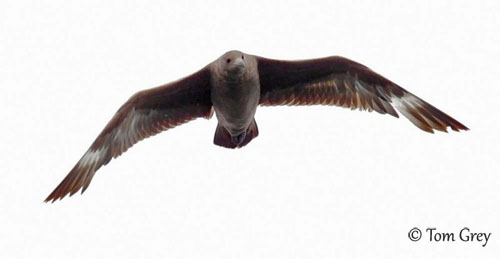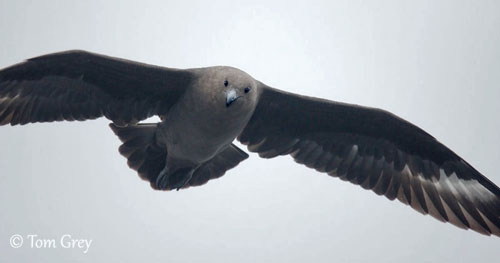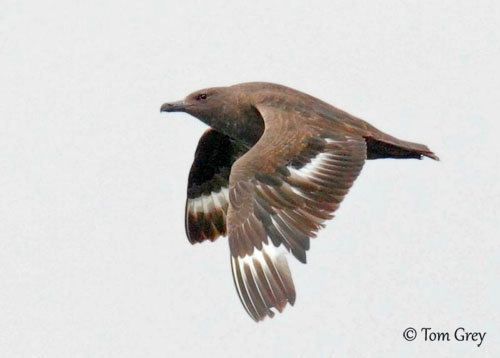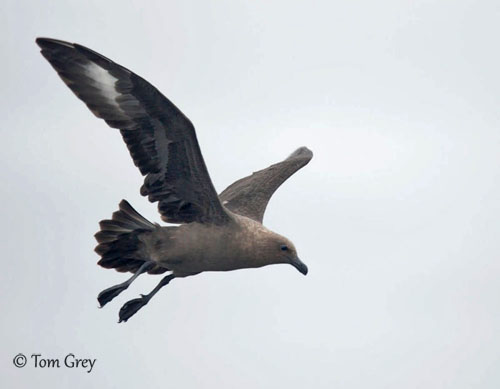
Fr: Labbe de Mc Cormick
All : Antarktikskua
Esp: Págalo Polar
Ital : Stercorario di McCormick
Nd: Zuidpooljager
Sd: Sydpolslabb
Photographer:
Tom Grey
Tom Grey's Bird Pictures
Text by Nicole Bouglouan
Sources:
HANDBOOK OF THE BIRDS OF THE WORLD Vol 3 by Josep del Hoyo-Andrew Elliott-Jordi Sargatal - Lynx Edicions - ISBN : 8487334202
SKUAS AND JAEGERS by Klaus Malling Olsen and Hans Larsson - Pica Press Sussex,
ISBN: 1873403461
BirdLife International (BirdLife International)
Bird Web (Seattle Audubon Society)
Wikipedia, the free encyclopaedia
South Polar Skua
Stercorarius maccormicki
Charadriiforme Order – Stercorariidae Family
BIOMETRICS:
Length: 50-55 cm
Wingspan: 130-140 cm
Weight: 900-1600 g
DESCRIPTION:
Similar to bulky, broad-winged gull, the South Polar Skua has dark, pale and intermediate morphs. This species differs slightly from other skuas in general body shape with slighter body, thinner bill, smaller head and narrower wings.
The adult in pale morph shows pale smoke-grey head and underparts, whereas wings, back and tail are dark brown with narrow pale streaks.
The contrast between upperparts and underparts can be fairly strong, with very pale underparts in some birds. Dark eyes and bill are striking on pale-headed birds. Legs and feet are dark grey.
The adult in dark morph has dark brown to blackish body, head and neck. Wings and back are sepia, with less contrast than in pale morph. We can see sometimes narrow pale streaks on mantle, and indistinct pale hind collar.
Bill, eyes, legs and feet are dark.
We can find an intermediate morph with dark hood and pale frontal wash, and sometimes dark-eye mask. Underparts are pale grey except the dark underwing-coverts.
On the upperparts, hindneck is often paler and contrasts with the dark hood. The mantle can be pale or dark, the latter often narrowly pale-streaked. The wings are all dark. Bill, eyes, legs and feet are dark brown to blackish.
In all morphs, there is the typical white wing patch at bases of primary flight feathers, and the broad, short tail. The birds become paler with age, and the adult plumage fades to paler tones through the breeding season. Usually, males are darker than females.

The juvenile is similar to intermediate adult, sometimes paler and greyer without any brownish wash or pale streaks. The upperparts are blackish with indistinct pale scaling.
The bill is two-tones with pale blue base and blackish tip. Legs and feet are pale.
VOICE: SOUNDS BY XENO-CANTO
The South Polar Skua can be noisy when feeding. A feeding group often produces a kind of “chatter” similar to that of farmyard ducks.
This species also gives high-pitched fast screams and shrieks like large gulls.
Outside the breeding grounds, it is usually silent.
HABITAT:
The South Polar Skua is marine. During winter, the species appears to be pelagic and during the breeding season, it feeds mainly at sea.
It breeds mainly on snow-free areas, sometimes close to penguin or petrel’s colonies. The nesting sites are mainly in coastal areas, but it also may form small inland colonies in snow-free mountainous areas.
RANGE:
The South Polar Skua breeds on Antarctic Continent and Peninsula, and especially in Ross Sea area where the pale morph birds predominate. The dark morph birds are more numerous on Antarctic Peninsula.
This species winters far north to Alaska and Greenland.

BEHAVIOUR:
The South Polar Skua feeds mainly on fish and krill during the breeding season, foraging several kilometres from colonies in flocks of about 100 birds. When they breed close to Brown Skuas, the South Polar Skua feeds mainly on fish, but if the Brown Skua is absent, it can feed on penguin eggs and chicks, and several birds may collaborate to take larger young or weak adults.
When nesting inland, the South Polar Skua feeds mainly on petrels. They also gather at carcasses and are known to kill sick or weak birds of their own species.
They also attack petrels and shags to steal their preys, often grabbing them on wings, tail or belly.
Outside the breeding season, they fish by plunge-diving and also follow and attack flocks of other medium-sized seabirds.
The South Polar Skua is highly territorial during the breeding season. This species is monogamous and pairs for life. It usually shows strong territory site fidelity.
It performs typical threat displays with wide open wings, exposing the white wing patches while calling. Physical attacks and fighting may occur, involving sometimes serious injuries.
In established breeding pairs, the pair-bond is re-established on the territory used year after year, but courtship displays are limited. They usually breed in loose colonies along the coasts.

The South Polar Skua is a long-distance migrant, leaving the breeding grounds in Antarctic in March. Then, it crosses the equator to reach its wintering areas throughout N Pacific and N Atlantic. This species is the commonest skua on Grand Banks of Newfoundland between May and August. They return in October-November to their breeding sites.
Migrating birds are mainly immature and juveniles, meaning that adults might remain close to their breeding areas as other skuas. The wintering grounds of the adults are unknown, but they probably lie in the pack ice of the southern oceans around Antarctica.
FLIGHT:
The South Polar Skua has powerful flight and performs fast wingbeats. However, it has less agile flight than smaller skuas.

REPRODUCTION:
The breeding season starts in November until February.
The South Polar Skua forms loose colonies on bare, open grounds along the coasts. The ground is often covered with lichens and mosses, in sheltered depressions free of ice or snow. There are several prominent rocky outcrops giving a good view over the territory.
The nest is an unlined scrape on the ground.
The female lays two eggs and the incubation lasts 28-31 days. At hatching, the chicks are covered with pale grey-brown down. They leave the nest 24/48 hours after hatching and fledge 36-45 days later.
But usually, only one chick survives because the older one often kills the younger chick. They are sexually mature at six years.

DIET:
The South Polar Skua feeds at sea on fish and krill which are its main food. It may take eggs and chicks of penguins if the Brown Skua is away from the area, but it usually feeds mainly on fish. During winter, the fish is probably complemented by scavenging.
PROTECTION / THREATS / STATUS:
The South Polar Skua has large range, and in spite of low breeding success and harsh weather conditions affecting chicks and adults, the populations do not appear endangered, and the species is evaluated as Least Concern by BirdLife International.
